Remember the ABA: Memphis Pros (original) (raw)
Did you see a Memphis Pros game? Or, did you have a favorite Pros player? Contribute to this web page by describing your favorite Pros memories.
Back to "Remember the ABA" Main Page
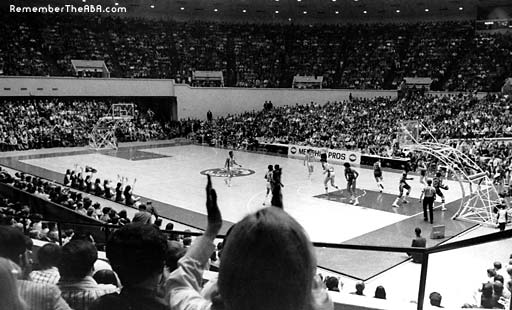 The ABA's Memphis franchise was like the Energizer Bunny -- even though it seemed like the franchise should stop, it kept going, and going, and going.....
The ABA's Memphis franchise was like the Energizer Bunny -- even though it seemed like the franchise should stop, it kept going, and going, and going.....
The franchise was first located in New Orleans, as the Buccaneers. The Bucs played a few games in Memphis every year, and drew encouraging crowds there. That made the New Orleans owners wonder whether the team might do better in Memphis. During the 1969-70 season, the Bucs faltered in the standings and in paid attendance. The owners decided to shake things up - they decided that for the 1970-71 season, the team would be known as the "Louisiana Buccaneers" and play its home games in New Orleans, Shreveport, Lafayette, Monroe and Baton Rouge. However, this regional concept was eventually scrapped, and the team's future was entirely up in the air.
Finally, on August 21, 1970, Mississippi resident P.W. Blake purchased the franchise. Ten days later, he made the decision to move the entire operation to Memphis. The team would play in a nice modern arena, the Mid-South Coliseum. The news was exciting for Memphis, as the ABA team would be the city's first and only major league team. But the timing of this move created a number of problems.
As of September 1, the Mid-South Coliseum had already been booked for most of the winter. Only 31 dates were available. After working with the league to juggle the entire ABA schedule, the team had to settle for nine Monday nights, ten Wednesdays, one Friday and two Sunday afternoon home dates. The team desperately asked for some additional Friday and weekend dates, but nothing could be done. The balance of the team's home games had to be moved outside Memphis to remote locations like Jackson, Mississippi. With this kind of schedule, the team had a difficult time selling season tickets (and any advance tickets for that matter). By the start of the regular season, only 180 season packages had been sold.
There was no community relations program. There was subtle anti-ABA pressure from Memphis State University, whose Tigers also played their home games in the Coliseum. The university didn't like the possible competition for basketball dollars.
Another "issue" was the team nickname and uniforms. On very short notice, the team picked the name "Memphis Pros." Upon learning of the new name, sportswriters all over the country declared that it was one of the most boring and unimaginative nicknames in all of sports. The true story behind the dubious nickname was a typical ABA cost-saving measure. The team had already decided to use the New Orleans uniforms left over from the year before. Those uniforms had the word "Bucs" sewn on the front. After removing the word "Bucs", a simple four-letter "replacement" nickname was needed. Apparently, the team could not think of any better candidate than "Pros." Of course, in the world of the ABA, once "Pros" was placed on the recycled uniforms, it was too expensive to change.
Fortunately, the team was able to keep more than just the New Orleans uniforms. It also able to keep key players such as Steve "Snapper" Jones (of NBA announcing fame), Jimmy Jones, and Gerald Govan. It was also lucky enough to retain Babe McCarthy as their coach.
On October 20, 1970, the Pros opened at home in front of an enthusiastic crowd. 3,200 fans (many holding free or discounted tickets) crammed into the Mid-South Coliseum to watch their new team play the New York Nets. Unfortunately, these new ABA fans went home disappointed as the Pros lost 108-103.
Two nights later, the Pros got their first home win, beating the Kentucky Colonels 109-99. But, it was back to reality from an attendance standpoint, as only 1,228 fans turned out to see the win. Attendance hovered around this disappointing level for the next several months, even though the Pros won 11 out of their first 19 games.
Overall, the Pros did surprisingly well in the ABA's tougher Western Division. While most observers picked them to finish last, they actually stayed close to the top most of the season. They beat eventual 1970-71 champion Utah 5 out of 12 times (while Dallas and Denver each managed only one victory against the powerful Stars). They also beat defending champion Indiana 4 out of 10 times.
| When he was healthy, Charlie Williams (above left, #10) was a quick-driving, unselfish guard who made all of his teammates better. Williams had played with the Pittsburgh/Minnesota Pipers for three years, before coming to Memphis.Burly forward Wendell Ladner (above right, #33) came to Memphis as a rookie in 1970. Ladner got into a few fights in his first few months in the ABA, and quickly gained a reputation as one of the league's most rough and physical players. He could always be counted on for a few dangerous collisions and dives during any given game. At the same time, he showed a feathery touch outside the three point line, unusual for a player his size. Guard Jimmy Jones (at right, # 15) could score on anybody. One of his favorite one-on-one moves was to post up a smaller guard, back the defender into the paint, and launch an impossible-to-block fadeaway. He played hurt with the Pros, but still managed 19.5 points per game. The 1970-71 season was his last with the New Orleans/Memphis franchise. He left for Utah when somebody in the Memphis front office overlooked the pickup date on his option, making him a free agent. | 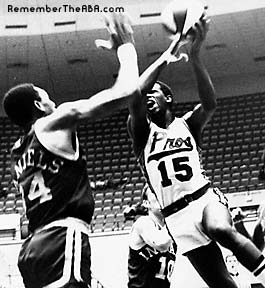 |
|---|
Steve Jones was the team's scoring leader with 22.1 points per game. At 6'5", he was able to dominate most other ABA guards, and even played a little forward when asked. On January 9, 1971, he hit a 35-foot three-pointer at the buzzer to give the Pros a 113-112 victory over the Chaparrals in Dallas. He won several other games for the Pros in the final seconds. Jimmy Jones averaged an impressive 19.5 points per game but was slowed by numerous nagging injuries.
Wendell Ladner, a 6'5" rookie out of Southern Mississippi, played with all-out hustle and effort every night. He took charges, ran down offensive rebounds, threw up three-pointers, and won a number of fights. He surprised everyone by averaging 16.9 points and 11.5 points per game. He was third in the 1970-71 rookie of the year balloting, behind Dan Issel and Charlie Scott. He even played in the 1971 ABA All-Star Game held at Greensboro, North Carolina (joining Issel and Scott as the only rookie participants).
Other players like Charlie Williams (longtime ABA standout guard) and Wil Jones (defensive stopper, tough on the boards) also made the Pros go.
The Pros lost 16 of their last 21 games to finish 41-43, good for third place in the Western Division (behind the two best teams in the ABA that year, Indiana and Utah). Due to the ABA's quirky playoff system, the Pros were matched up with the first-place Pacers in the first round of the 1971 ABA Playoffs. They gave the heavily-favored Pacers all they could handle. Game 1 was a Pacers blowout in Indianapolis. In Game 2, also at Indiana, the Pros led the Pacers by 9 in the fourth quarter (91-82), but Freddie Lewis hit two free throws with 1 second left in the game for a 106-104 Pacers win. For Game 3 at Memphis, 4,107 fans came out to see the Pros lose another heartbreaker 91-90. Steve Jones led the team with 31 clutch points. In Game 4, in front of 3,681 fans, the Pros played with desperation, but lost 102-101 in overtime. It certainly didn't feel like a sweep, but the Pros' first season was over.
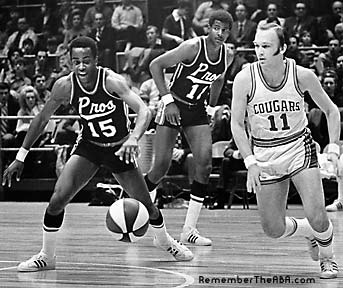 |
The players in these photos formed the heart and soul of Babe McCarthy's Memphis Pros. The four players in the above left photo (from left to right, Jimmy Jones, Wendell Ladner, Gerard Govan and Steve "Snapper" Jones) caused a lot of problems for ABA opponents. Steve Jones was a dangerous jump shooter. Jimmy Jones (also at left, # 15) could score from anywhere. Govan (also above right, # 25) was a feared rebounder. And Ladner was just feared, period. With the hard-working Wil Jones (#11, at left) also in the mix, the Pros were a good team. |
|---|
Off the court, the Pros were a mess. Only two months into the season, new owner Blake surprised everyone by "throwing in the towel." Claiming that he had already lost $200,000 on the team, he turned over the Pros to the league office. He wanted no further part of the franchise. After this bombshell, the ABA had to operate the team on a shoestring budget (while seeking new ownership for the franchise). New General Manager Charlie Cavagnaro, who had been a sportswriter until the Pros moved to Memphis, was put into a difficult situation. He submitted numerous unpaid bills to the league office, cut costs any way he could, and tried to keep the team's front office in place.
Finding new ownership to keep the team in Memphis seemed impossible. No corporate money was found. Wealthy Memphis residents were not interested. Just when it looked like the team would be sold to out-of-state interests (who would move the team), the regular citizens of Memphis came to the rescue. They bought shares of stock in the Pros in a "Save Our Pros' public offering held on February 12, 1971. Those who wanted to keep the state's only major league team came to the Pros' offices and paid 5,or5, or 5,or10, or 50forProsstockcertificates.Over4,000Tennesseeansboughtstockintheteam.Onedogalsogotinontheaction.TwoMarinesatthelocalNavalAirStationwerenotallowedtobuyshares,sincetheywerenotTennesseeresidents.Sotheyboughtsomesharesinthenameoftheirstation′smascot,abulldog.TheABAtookabout50 for Pros stock certificates. Over 4,000 Tennesseeans bought stock in the team. One dog also got in on the action. Two Marines at the local Naval Air Station were not allowed to buy shares, since they were not Tennessee residents. So they bought some shares in the name of their station's mascot, a bulldog. The ABA took about 50forProsstockcertificates.Over4,000Tennesseeansboughtstockintheteam.Onedogalsogotinontheaction.TwoMarinesatthelocalNavalAirStationwerenotallowedtobuyshares,sincetheywerenotTennesseeresidents.Sotheyboughtsomesharesinthenameoftheirstation′smascot,abulldog.TheABAtookabout100,000 less than its $800,000 asking price, and told the club to spend the rest on the team itself. A 24-member board of directors was appointed for the new corporate owner, Memphis Area Sports Inc. The stock offering became known as the "Memphis Miracle."
There was some more good news for the Pros during the summer of 1971. The team drafted and signed precocious young guard Johnny Neumann. As a junior at Ole Miss, Neumann had led the nation and the SEC in scoring at 40.1 points per game. In terms of raw talent, many compared him to Pete Maravich.
The Pros needed Neumann because two of the "Jones Boys" had finally departed for greener pastures. Tired of his meager salary, Steve Jones opted out of his Memphis contract. He happily jumped to the Dallas Chaparrals for a three-year 210,000deal.Also,thePros′frontofficeinexplicablyfailedtoexerciseateamoptiononthecontractofJimmyJones.WhentheUtahStarsofferedhim210,000 deal. Also, the Pros' front office inexplicably failed to exercise a team option on the contract of Jimmy Jones. When the Utah Stars offered him 210,000deal.Also,thePros′frontofficeinexplicablyfailedtoexerciseateamoptiononthecontractofJimmyJones.WhentheUtahStarsofferedhim100,000 a year for four years, he bolted out of Memphis for Salt Lake City.
For the 1971-72 season, the Pros were left with a core group of Neumann, Charlie Williams, Wendell Ladner, Wil Jones, Bobby Warren and Gerald Govan. McCarthy remained as the coach. This group hustled, rebounded well and played hard (as always the case with a McCarthy-coached team). At least at the beginning of the season, the "new" Pros won their fair share of games.
On October 20, 1971, the Pros surprised themselves by almost upsetting the Colonels in Louisville. With 11 seconds remaining in the contest and the Pros trailing Kentucky by three points, Coach McCarthy told three-point bomber Wendell Ladner to try a home run if open, but to pass the ball if closely covered. Ladner proceeded to throw up a 28-foot off-balance fade-away three-pointer in the face of two defenders. He missed badly. After the close loss, McCarthy said of Ladner: "That boy should have paid more attention in school during his math and English lessons."
In early November, the Pros went on a rare two-game road winning streak. On November 12, 1971, they defeated Dallas 107-103 (despite 29 points from former teammate Steve Jones). The next day Memphis upset the Utah Stars in Salt Lake City by the score of 125-116. Charlie Williams scored 29 points to boost the Pros.
On December 3, in one of those "home" games at Jackson, Tennessee, the Pros halted the defending champion Stars' ten-game winning streak. This time Ladner followed McCarthy's instructions and hit an open three-pointer with 22 seconds left in regulation to tie the score at 103-103. Memphis won the game in overtime 117-114.
During the early part of the season, Govan and Wil Jones averaged over 30 rebounds per game between them (Govan got 17.1 and Jones got 13.1 per game). They made the Pros the best rebounding team in the ABA with a 59.3 per game average. Govan, always a reluctant shooter, stated: "I'd like to score more, but I'm convinced that I'll never be a great scorer. My big thing is to get the ball." For his part, Jones noted: "The coaches stress that the game is won or lost on the boards. But it's something you've got to like to do well. I just try to be best at my job."
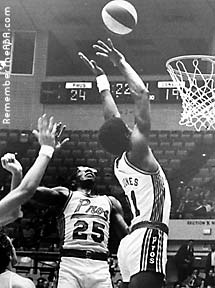 |
If there was a bright side to the 1971-72 Memphis Pros, it was the play of these two hard-working players, Gerald Govan (#25, above left and left) and Wil Jones (#11, above right and left). The Pros never had a dominating center, but Govan and Jones provided plenty of rebounding hustle on both ends of the court. They made the Pros the best rebounding team in the ABA in 1971-72. Govan averaged 14.2 rebounds per game, and Jones averaged 10.4. Early in the season, their averages were even higher. Govan would finally leave the New Orleans/Memphis franchise after this season. He went to Utah to play with former teammate Jimmy Jones. Jones, on the other hand, suffered through two more years of Memphis misery with the Charlie Finley-owned Tams. Finally, after the 1973-74 season, Jones signed on with the Kentucky Colonels and won a championship there under coach Hubie Brown. |
|---|
On January 3, 1972, the Pros completed a blockbuster trade with the Carolina Cougars. The Pros gave up their two leading scorers, Wendell Ladner and Bobby Warren, plus rookie center Tom Owens, in exchange for Randy Denton, Warren Davis and George Lehmann. Strangely, Coach McCarthy was not consulted about the trade. The trade was the work of new Pros president A.W. Hart, a Memphis stockbroker who was elected to his position with the team after purchasing $25,000 worth of Pros stock. Hart, who had no background in basketball, initiated contacts with the Cougars and negotiated the trade on his own. He apparently pursued the deal after attending a few games and noting that the Pros needed an inside scoring threat. He felt that the 6'11" Denton would get the Pros more points in the paint. Most observers felt that the trade was extremely lopsided in favor of the Cougars. In public, McCarthy expressed some hurt feelings that he had not been consulted earlier about the deal. In private, he was infuriated and knew that this signalled the end of his involvement with the team.
The night after the trade, the Pros hosted the Stars and were blown out 114-89. Memphis fans put up banners all over the Mid-South Coliseum protesting the trade. One banner summed up the feeling of the fans: "Keep The Players And Trade Management." The fans were especially irritated at losing Ladner, a fan favorite. The Pros actually played better for a very brief stretch after the trade, prompting McCarthy to make peace with Hart (in a sarcastic sort of way):
"I was against the trade at the time. But it's been great for us. It's changed us all around. People were starting to catch up with my shuffle. So many of my ex-players are around the league now that they all knew the keys and they were overplaying our strengths all the time. Randy Denton has really come along in the middle and George Lehmann has given much more leadership than we had before. I was against the trade because I believe in experience and continuity. But these guys are at the same place the other guys were when they left and these fellas should improve. I told A.W. that if he can come up with any more trades like that one to go ahead and make 'em. He's a real go-getter and I'm all for him."
On January 14, 1972, the Pros broke an ABA record by scoring an amazing 52 points in the 4th quarter of a loss against the Pacers in (of all places) Toronto, Canada. The game was part of an ABA doubleheader designed to gauge Canadian interest in the red, white and blue league (the second game featured Kentucky vs. Dallas). The event attracted 7,225 curious fans to the Maple Leaf Gardens on a bitterly cold night in Toronto.
In mid-February, the Pros' record stood at 23-36 - last place in the Western Division, but only half a game behind the Denver Rockets for the last playoff spot. The Pros faced an uphill battle to catch Denver, as 20 out of their final 28 games were on the road.
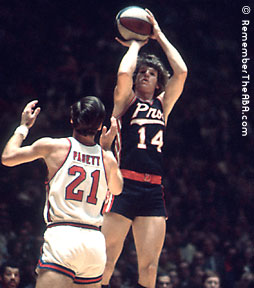 It didn't help when McCarthy and Neumann began to openly feud about the rookie's attitude and playing time. McCarthy pulled Neumann out of a 123-110 loss at Indiana on February 13, and the two exchanged sharp words. McCarthy ordered Neumann to sit on the end of the bench, and Neumann responded by yelling "That's fine with me, [censored]." McCarthy then banished Neumann to the dressing room for the entire fourth quarter and fined him $100. After the game McCarthy questioned Neumann's defense and maturity, while Neumann bluntly stated: "I'll pay the fine but McCarthy treats me like a dog. I've had to bow and scrape to him so I can play. If I make one mistake I get yanked out of the game. Other guys can make three or four mistakes before they get taken out. " A team practice the day after the incident was frequently interrupted by TV crews pulling first Neumann and then McCarthy for interviews to hear the different sides of the incident. When the Pros played at Utah on February 15, Neumann was not in the starting lineup, but he did score 14 points off the bench in the 118-99 loss (the 6th in a row for the Pros).
It didn't help when McCarthy and Neumann began to openly feud about the rookie's attitude and playing time. McCarthy pulled Neumann out of a 123-110 loss at Indiana on February 13, and the two exchanged sharp words. McCarthy ordered Neumann to sit on the end of the bench, and Neumann responded by yelling "That's fine with me, [censored]." McCarthy then banished Neumann to the dressing room for the entire fourth quarter and fined him $100. After the game McCarthy questioned Neumann's defense and maturity, while Neumann bluntly stated: "I'll pay the fine but McCarthy treats me like a dog. I've had to bow and scrape to him so I can play. If I make one mistake I get yanked out of the game. Other guys can make three or four mistakes before they get taken out. " A team practice the day after the incident was frequently interrupted by TV crews pulling first Neumann and then McCarthy for interviews to hear the different sides of the incident. When the Pros played at Utah on February 15, Neumann was not in the starting lineup, but he did score 14 points off the bench in the 118-99 loss (the 6th in a row for the Pros).
A week later, in a rematch with the Pacers in Memphis, Neumann went for a career-high 38 points. But the Pros continued their slide by losing their ninth straight game, 131-127 in double overtime. They squandered a 22-point third quarter lead and a 4 point lead with only 26 seconds to go in regulation.
As Memphis played out the string, Neumann had games of 24, 35 and 40 points to raise is scoring average to 16.9 points per contest - but this was little consolation to the Pros as they fell further and further into the Western Division cellar. On March 18, 1972, in a game at Carolina, Neumann and the other Pros tried to "guard" Larry Miller, but allowed the Cougars forward to score an ABA-record 67 points. It was a humiliating display and put Neumann's lack of defense in a bright spotlight.
| Coach McCarthy called January 3, 1972 "the day the deal was made, the day they traded my ballclub away." The blockbuster deal was a three-for-three trade with the Carolina Cougars. Memphis gave up its two top scorers at the time: scrappy and popular Wendell Ladner (above right, # 33) and fourth-year man Bobby Warren (above left, # 21). Memphis also parted with 6'10" rookie center Tom Owens. In return, Memphis received George Lehmann, Warren Davis and Randy Denton. After playing in only 15 games, Lehmann got hurt and sat out the rest of the year. The Pros were 16-33 when the trade was made, and 10-35 the rest of the way. Most of the scoring load after the trade fell on brash rookie guard Johnny Neumann (right, #14). In college, Neumann had been compared to Pete Maravich due to his high scoring average. With the Pros, Neumann occasionally showed flashes of scoring brilliance. But more often than not he bickered with Coach McCarthy and struggled on the court, especially on defense. | 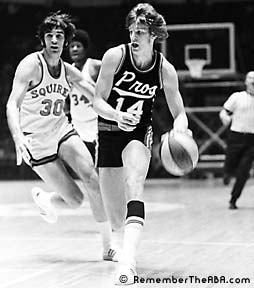 |
|---|
The Pros went a pitiful 3-22 over their last 25 games (and only 10-33 after the big January trade supposedly designed to improve the team). They ended the 1971-72 season with a 26-58 record. They missed the playoffs for the first time in the team's five-year history.
By the end of the season, the team's money problems had come to the forefront once again - the league had taken over the operation of the franchise for a second time. On April 27, 1972, McCarthy resigned his coaching position with the team - ending the longest coaching tenure in the league. He hooked on with the Dallas as the Chaparrals' new coach. Finally, on June 13, 1972, when it looked like the team would have to move to another city to survive, Charlie Finley bought the franchise and announced he would keep it in Memphis. It was the beginning of the very strange story of the Memphis Tams.
Pros Fan Memories
Pros 1970-72 Road Uniform
MEMPHIS PROS YEAR-TO-YEAR RESULTS
1970-71 Memphis Pros
Record: 41-43, Third Place in Eastern Division
1971 Playoff Results:1971 Eastern Division Semifinals vs. Indiana Pacers (58-26)
Pacers won series, 4-0
1971-72 Memphis Pros
Record: 26-58, Fifth Place in Western Division
Missed Playoffs
1972-73 Under New Management (Memphis Tams)
Thanks to John G. Schmitz and Jon Singer for their valuable contributions to this page.